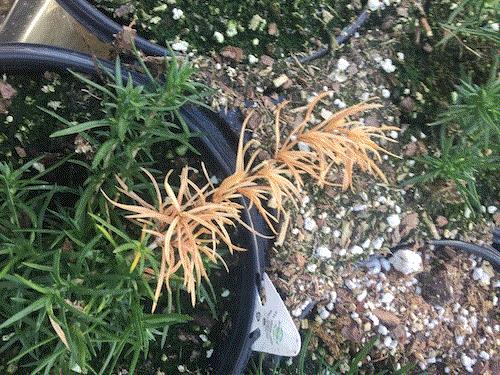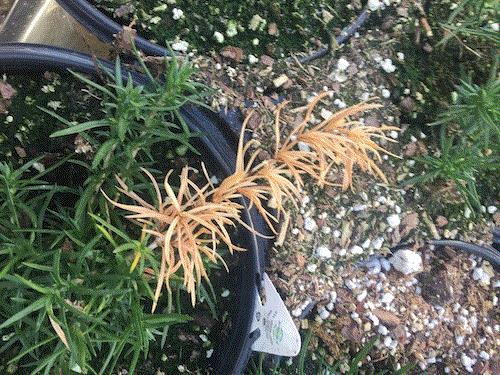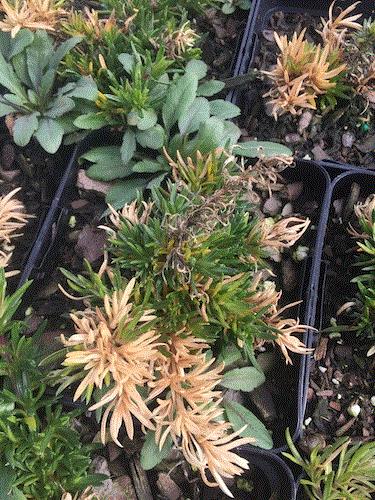What's Happening Here?
In this week's challenge, I thought I'd share a problem that many perennial growers often observe this time of year. Take a look at this symptom on Phlox subulata:

If you've grown Phlox subulata in the past, I'm guessing many of you likely have seen plants with similar symptoms. Did you get it diagnosed? This is a common issue, but since I see it every year at one or more growing facilities, I'm guessing many growers aren't aware of its cause or how to manage this issue.
So, before I reveal its cause, let me ask you, "What's happening here?" Read on to find out.
Fall EOPs

In recent issues, I announced early order programs (aka EOPs) from Bayer, BASF and Western Pulp Products (ask your distributor for program details). These programs can be an excellent opportunity to save money on products you'll be using between now and next June. The promotions vary from company to company, but often consist of significant discounts, extended payment terms special rebates and/or free product. Here are some more EOPs for you to check out:
Syngenta
Syngenta is offering the best savings of the year with its GreenTrust 365 Ornamental Program. The early order period for this program is October 1, 2019 through December 6, 2019. During this period, significant savings will be offered on over 25 plant protection products and Multipaks.
Purchases of at least $5,000 worth of qualifying products during the month of October automatically qualifies growers for the program, a year-long rebate and a GT Bonus Booster rebate of 3% on top of their yearlong rebate. The program also has a deferred payment option with no payments until June 26, 2020.
Click here for GreenTrust 365 Ornamental Program details.
Nufarm
Nufarm is offering an EOP program through its Nufarm Edge Rewards Program. You must register on their website to qualify for the rewards. The rewards are in the form of distributor credit rebates.
There are two periods in the EOP program: the first period offers the highest rewards (at least double the rewards offered during period two). EOP 1 runs from September 16 through October 31, 2019; EOP 2 runs from November 1 through December 6, 2019.
Click here for Nufarm Edge Rewards EOP details.
More EOPs
Here are a few more companies I'm aware of that are offering EOPs. Click the program names below for EOP information.
SePRO Pinnacle Program
Corteva Agriscience Ultimate Rewards
FMC True Champions EOP Rewards
Here are a couple of the ones I discussed in a previous newsletter:
BASF Fall Grower Event
Bayer—Broadform Fall Program
Bayer—Marengo Fall Program

Upcoming FREE Webinars
Improving Nursery Weed Control with Herbicide Rotations and Production Practices

Come join us at 1:00 p.m. Eastern/12:00 p.m. Central on Thursday, October 3, 2019 for an informative webinar about weed control. The presentation will be given by industry experts Chris Marble, University of Florida, Mid-Florida Research and Education Center, and Aaron Palmateer, Bayer Senior Technical Services.
During this one-hour webinar, attendees will learn about:
-
Preemergence trial results with 25-plus herbicides and combinations, including traditional and recently released products
-
Effective preemergence options for key troublesome weed species
-
Selecting the best herbicides for your product mix and developing effective rotations
-
Proven non-chemical strategies for herbicide-sensitive crops
The "A to Z" of Growing Perennials in HydraFiber

Here's a new one for me—a little self-promotion if you don't mind. I'll be co-presenting this free webinar with Daniel Norden, Profile Product's Senior R&D Specialist Manager, at 1:00 p.m. Eastern/12:00 p.m. Central on Thursday, October 17, 2019.
I'm still finalizing the content for the webinar, but I'm planning to offer several tips and "keys to success" when it comes to transitioning to and growing perennials using substrates containing HydraFiber. Daniel will share recent university and grower trial results on perennials and shrubs.
I'm looking forward to both of these great webinars. Click here to register for these FREE webinars, generously sponsored by Bayer and HydraFiber Advanced Substrate, respectively.

Wage & Benefit Surveys
I'd like to extend an invitation for you to participate in the 24th Annual GrowerTalks Wage & Benefit Survey (for growers) and the 11th Annual Green Profit Wage & Benefit Survey (for retailers and grower-retailers) sponsored by Florasearch, Inc. Each survey takes approximate five minutes to complete and participants will be eligible to win a new 128GB iPad.
The results will be published in upcoming issues of GrowerTalks and Green Profit magazines. Thank you in advance for your participation and good luck with the iPad drawing.
Click here for the GrowerTalks grower survey.
Click here for the Green Profit retailer and grower-retailer survey.
The Answer is ...
At the top of the newsletter, I showed this image of Phlox subulata and challenged you to determine the cause of the symptoms:

Before I reveal the answer, take a look at more progressed symptoms:

If no management strategy is implemented, these symptoms can progress and cause the entire plant to turn brown. When symptoms progress, the plants are no longer marketable and many of them may even eventually die.
So what have you come up with? Do you think the brown stems are caused by insect, disease, chemical damage, nutritional, abiotic disorder or other? Although there may be right and wrong answers, there's no such thing as a bad guess. Okay, by now you've locked in your answer.
If you answered colletotrichum, you nailed it and I'm guessing you've been face-to-face with this fungal disease before. If you answered anthracnose, you're also right, as colletotrichum is one of several anthracnose pathogens.
Managing This Issue
I'll be honest with you, this is a tough one. It seems like once you see symptoms, the disease doesn’t go away. Growers who experience it often implement a serious amount of what I call chemotherapy. In addition to frequent fungicide applications, there are a few things you can do.
If you're fortunate to only have a plant or two showing symptoms, consider carefully removing them from the crop and discarding them. At the very least, carefully trim off the infected brown stems.
Colletotrichum requires periods of leaf wetness to attack the plant and spreads from plant to plant via splashing water. If possible, avoid extended periods the leaves remain wet and take steps to allow the foliage to dry quickly (wide spacings and/or lots of air movement).
As far as the chemotherapy goes, I find it best to implement a preventative spray program using fungicides highly effective at controlling colletotrichum. Some of the best fungicide I frequently turn to are Orkestra, Phyton 27, Spectro 90 and Strike Plus. Apply a rotation of these products at 14- to 21-day intervals when there are no symptoms present. If you have some symptoms, rotate these products at sven- to 10-day intervals until the progression of the symptoms have stopped.




Thanks for reading this edition of Perennial Pulse. Please let me know if you have any questions or article ideas for future newsletters.
My email is ppilon@ballpublishing.com.
Take care,
Paul Pilon
Editor-at-Large
Perennial Pulse
This email was received by you and over 34,319 subscribers!
If you're interested in advertising in Perennial Pulse, contact Kim Brown ASAP and she'll hook you up.